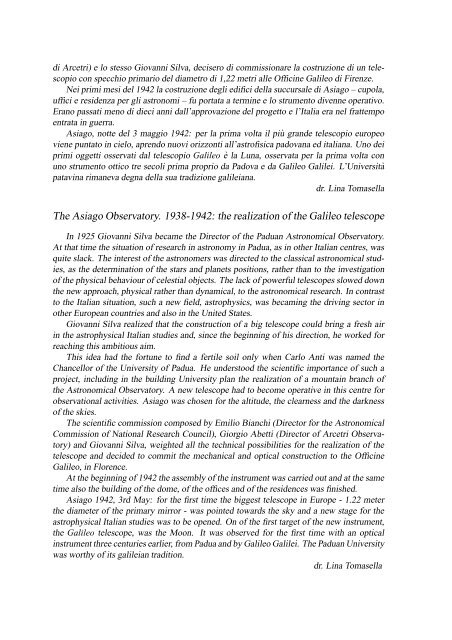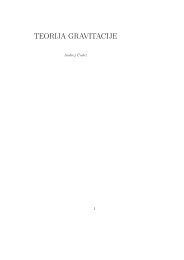uncompressed pdf
uncompressed pdf
uncompressed pdf
Create successful ePaper yourself
Turn your PDF publications into a flip-book with our unique Google optimized e-Paper software.
di Arcetri) e lo stesso Giovanni Silva, decisero di commissionare la costruzione di un telescopio<br />
con specchio primario del diametro di 1,22 metri alle Officine Galileo di Firenze.<br />
Nei primi mesi del 1942 la costruzione degli edifici della succursale di Asiago – cupola,<br />
uffici e residenza per gli astronomi – fu portata a termine e lo strumento divenne operativo.<br />
Erano passati meno di dieci anni dall’approvazione del progetto e l’Italia era nel frattempo<br />
entrata in guerra.<br />
Asiago, notte del 3 maggio 1942: per la prima volta il più grande telescopio europeo<br />
viene puntato in cielo, aprendo nuovi orizzonti all’astrofisica padovana ed italiana. Uno dei<br />
primi oggetti osservati dal telescopio Galileo è la Luna, osservata per la prima volta con<br />
uno strumento ottico tre secoli prima proprio da Padova e da Galileo Galilei. L’Università<br />
patavina rimaneva degna della sua tradizione galileiana.<br />
dr. Lina Tomasella<br />
The Asiago Observatory. 1938-1942: the realization of the Galileo telescope<br />
In 1925 Giovanni Silva became the Director of the Paduan Astronomical Observatory.<br />
At that time the situation of research in astronomy in Padua, as in other Italian centres, was<br />
quite slack. The interest of the astronomers was directed to the classical astronomical studies,<br />
as the determination of the stars and planets positions, rather than to the investigation<br />
of the physical behaviour of celestial objects. The lack of powerful telescopes slowed down<br />
the new approach, physical rather than dynamical, to the astronomical research. In contrast<br />
to the Italian situation, such a new field, astrophysics, was becaming the driving sector in<br />
other European countries and also in the United States.<br />
Giovanni Silva realized that the construction of a big telescope could bring a fresh air<br />
in the astrophysical Italian studies and, since the beginning of his direction, he worked for<br />
reaching this ambitious aim.<br />
This idea had the fortune to find a fertile soil only when Carlo Anti was named the<br />
Chancellor of the University of Padua. He understood the scientific importance of such a<br />
project, including in the building University plan the realization of a mountain branch of<br />
the Astronomical Observatory. A new telescope had to become operative in this centre for<br />
observational activities. Asiago was chosen for the altitude, the clearness and the darkness<br />
of the skies.<br />
The scientific commission composed by Emilio Bianchi (Director for the Astronomical<br />
Commission of National Research Council), Giorgio Abetti (Director of Arcetri Observatory)<br />
and Giovanni Silva, weighted all the technical possibilities for the realization of the<br />
telescope and decided to commit the mechanical and optical construction to the Officine<br />
Galileo, in Florence.<br />
At the beginning of 1942 the assembly of the instrument was carried out and at the same<br />
time also the building of the dome, of the offices and of the residences was finished.<br />
Asiago 1942, 3rd May: for the first time the biggest telescope in Europe - 1.22 meter<br />
the diameter of the primary mirror - was pointed towards the sky and a new stage for the<br />
astrophysical Italian studies was to be opened. On of the first target of the new instrument,<br />
the Galileo telescope, was the Moon. It was observed for the first time with an optical<br />
instrument three centuries earlier, from Padua and by Galileo Galilei. The Paduan University<br />
was worthy of its galileian tradition.<br />
dr. Lina Tomasella



